Except for being digitised, research papers haven’t changed much since they began over 350 years ago.
That’s not to say there haven’t been calls for change. Scholars and others continue to debate the function and future of the scientific paper, exploring how open access and potential changes to incentive structures might influence the way research outputs evolve in the future, and the age-old question of: who pays?
Some scholars are right to argue that research communication is already in transition. We see more and more academics experimenting with different research outputs, sharing research via blogs, social media, and using repositories and preprint servers. While many non-traditional activities can be tracked by altmetrics providers, traditional journal impact measures are likely to dominate for as long as they remain tied to incentive structures.
Our research points to several reasons why the traditional scientific paper might not be fit for the future, supporting the drive for a range of research outputs.
On this page
- Long, text-heavy & full of jargon
- How students engage with academic content
- How well do research outputs translate outside of academia?
- Most-wanted content types
- Top social media channels
- Future trends in social media
- Top social media channels for sharing research
- Impact of COVID-19 on research
In the report
Long, text-heavy & full of jargon
Which of the following do you consider are challenges with academic research papers?
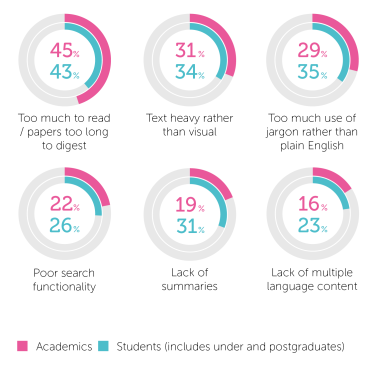

| Response | Academics % | Students % |
|---|---|---|
| Too much to read / papers too long to digest | 45 | 43 |
| Text heavy rather than visual | 31 | 34 |
| Too much use of jargon rather than plain English | 29 | 35 |
| Lack of remote access when off campus | 27 | 26 |
| Confidence the source is trustworthy | 26 | 31 |
| Knowing where to find content in the first place | 24 | 32 |
| Poor search functionality | 22 | 26 |
| Lack of summaries | 19 | 31 |
| Lack of multiple language content | 16 | 23 |
| Lack of accessibility for e.g. visually impaired / hearing loss | 16 | 20 |
| I don’t think there are any challenges with academic research papers | 12 | 6 |
| Other | 9 | 6 |
'Many articles and journals are so technical with jargon that many people soon switch off. It would be much easier if these were written in plain everyday language that the average person can digest and retain.' Student in Australia
'Sometimes a simple jargon buster is needed, a lot of complicated words have a very simple secondary word which would have been used instead.' Undergraduate student in UK
'Overuse of mathematical equations and calculations resulting in unintelligible outputs'. Academic in Australia
'Sometimes it would be nice to see shorter articles. The requirement for extensive literature reviews and showing that you know what you’re talking about is tedious, and sometimes unnecessary (just seems to serve previous authors). Say what you have found and get on with it.' Academic in USA
'We have to come up with a better way to present and digest article information. Most of us don’t have 20 hours a week to read articles – how we can access the information, identify top articles (and best articles that have not been out long enough for citations to indicate) to help us sift through the irrelevant or poor academic articles.' Academic in USA
'I dislike the pressure from publishers to transfer devices appropriate to teaching (quizzes, boxes, graphics, etc.) to research articles and monographs, where they are not helpful.' Academic in UK
Nearly half of students and academics say that research papers are too long and too text heavy. Another top concern is the use of jargon rather than plain language, particularly for academics in Australasia (38%), India (32%) and North America (49%), and students in China (49%) and the USA (56%).
Other challenges for students include lack of summaries (31% students vs. 19% academics), knowing where to find content in the first place (32% students vs. 24% academics). 23% students see the lack of multiple language research content as a challenge, particularly in China (40%), India (28%) and USA (39%). 16% of academics find a lack of multiple language content a problem, apart from those in Latin America where it’s an issue for 41%.
Having confidence that research is from a trustworthy source is important to both students and academics. 1 in 4 academics (26%) cited trust as a major challenge, with Australasian academics (34%) the most concerned, compared to other regions of the world. For students, trust is a major worry to those in Brazil (43%), China (42%) and Egypt (34%).
A small minority of academics (12%) and students (6%) don’t see any challenges with research papers.
See regional breakdowns of the results for students and for academics.
How students engage with academic content
Which of the following best describes your habits when reading academic content?
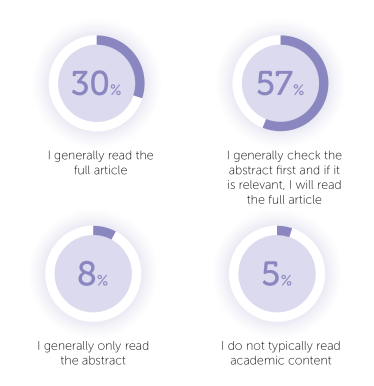

| Response | Percentage |
|---|---|
| I generally read the full article | 30 |
| I generally check the abstract first and if it is relevant, I will read the full article | 57 |
| I generally only read the abstract | 8 |
| I do not typically read academic content | 5 |
Despite its challenges, most students will read a research paper if relevant. Students generally check an abstract first and, if useful, go on to read the full article. However, nearly one third of students will read the full article – and this rises to more than half in India and the USA, but only 10% in Japan.
Students switch off from academic content after 28 minutes.
On average students engage with academic content for 28 minutes before they ‘switch off’. Over a quarter of students in China say they never switch off and students in the USA are more likely to switch off than any other country.
How well do current research outputs translate outside of academia?
Do you think the way research is currently makes it easy or difficult to use outside of academia?

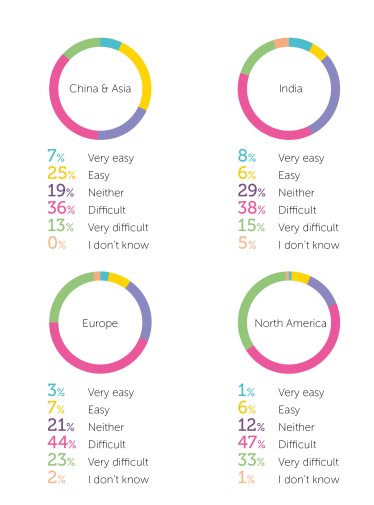
| Regional breakdown | Very easy % | Easy % | Neither % | Difficult % | Very difficult % | Don't know % |
|---|---|---|---|---|---|---|
| Overall | 6 | 12 | 21 | 40 | 20 | 2 |
| Australasia | 0 | 6 | 21 | 41 | 19 | 4 |
| China and Asia | 7 | 25 | 19 | 36 | 13 | 0 |
| India | 8 | 6 | 29 | 38 | 15 | 5 |
| Latin America | 2 | 10 | 16 | 47 | 24 | 0 |
| Middle East & Africa | 11 | 18 | 22 | 31 | 16 | 2 |
| Europe | 3 | 7 | 21 | 44 | 23 | 2 |
| North America | 1 | 6 | 12 | 47 | 33 | 1 |
Most academics (60%) agree that the way research is currently presented makes it difficult or very difficult for research to be used outside of academia. 32% of academics in China, East Asia and Northern Africa believe that it is easy or very easy for research to be used outside of academia, while only 6% of academics in Australasia and 7% in North America believe the same.
Three in five academics believe it is difficult or very difficult for research to be used outside of academia. Fewer than one in five think it's easy or very easy.
70% of academics in Australasia and 80% in North America agree that it is difficult or very difficult to use research outside of academia, while in China and Asia and Northern Africa just under half agree the same.
The difficulty of using research outside of academia is a challenge that has been discussed in previous Emerald reports. In our Global inclusivity report 2020, academics agreed then that the single biggest way research can become more impactful is through greater knowledge exchange with those outside academia.
Most-wanted content types – students
Top three content types students want to see used more at university [see below for academics].
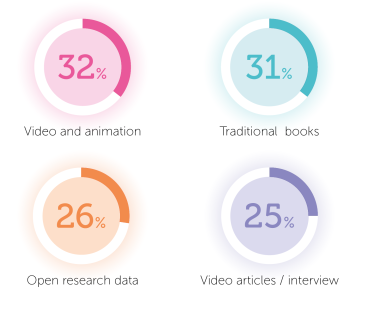
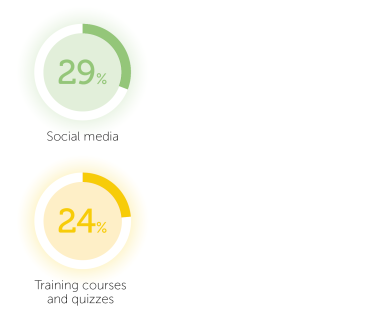
| Content type | Percentage |
|---|---|
| Video and animation | 32 |
| Traditional books | 31 |
| Social media | 29 |
| Open research data | 26 |
| Video articles/interview | 25 |
| Training courses and quizzes | 24 |
Students believe a combination of traditional methods along with technology would aid their learning at university. 26% of students favour the use of open research data (rising to 47% in China) and 25% prefer video articles/interview.
They also think learning could be enhanced through training courses and quizzes (24%), case studies (23%), podcasts (23%), journal articles (23%), infographics (22%), annotated articles (21%), structured abstracts (21%) and games (21%).
Quizzes to test knowledge proved popular in Australia (43%), China (39%), USA (30%) and Europe (23%).
Most students agree that supplementary material alongside a journal article or book chapter would aid their learning. Students in China are most in favour, with 97% choosing this option.
See a regional breakdown of the results
Most-wanted content types – academics
The content types academics would prefer for research presentation (aside from traditional formats).


| Content type | Percentage |
|---|---|
| Journal articles | 59 |
| Traditional books | 34 |
| Open research data | 31 |
| Training courses | 31 |
| eBooks | 29 |
| Video and animation | 29 |
Academics would like to see research presented via traditional and new content types. However, they still prefer journal articles over all other formats, with 59% of academics (rising to 64% in India) rating them as ‘very attractive’.
Traditional books continue to appeal to academics, with 34% choosing this option, rising to 43% in Europe. Academics are least keen on early stage synopses (9%) and de-jargoning software (8%). Open research data ranks highly for 31% of academic respondents, as well as 26% of undergraduate/postgraduates.
The tables below show a fuller breakdown for both types of user, and regional breakdowns are also available for students and for academics.
Students: Which of the following content forms would you like to see used more in the future to help you with your learning and make research papers more useful at university?
Academics: Using the scale of ‘1. Not at all attractive’ to ‘5. Very attractive’, how attractive are the following formats below, as a way to present academic research beyond traditional formats?
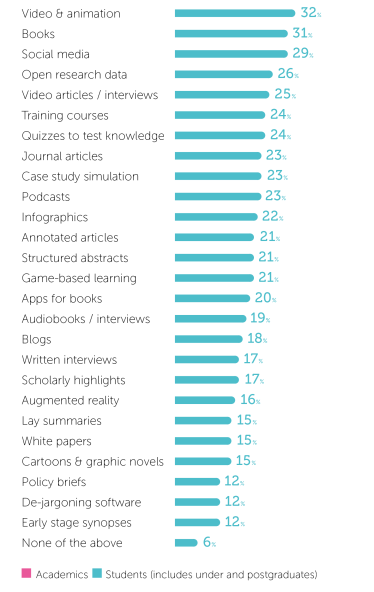
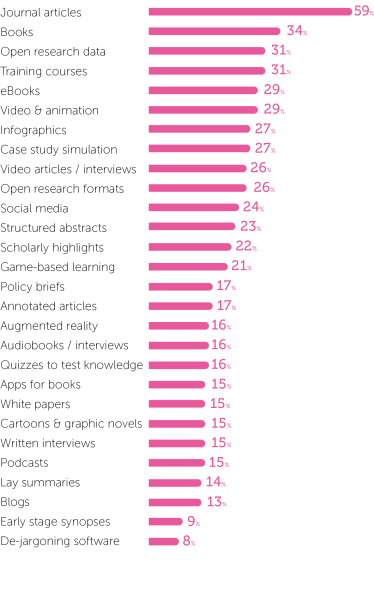
| Content type | Percentage |
|---|---|
| Video and animation | 32 |
| Books | 31 |
| Social media | 29 |
| Open research data | 26 |
| Video articles/interviews | 25 |
| Training courses | 24 |
| Quizzes to test knowledge | 24 |
| Journal articles | 23 |
| Case study simulation | 23 |
| Podcasts | 23 |
| Infographics | 22 |
| Annotated articles | 21 |
| Structured abstracts | 21 |
| Game-based learning | 21 |
| Apps for books | 20 |
| Audiobooks/interviews | 19 |
| Blogs | 18 |
| Written interviews | 17 |
| Scholarly highlights | 17 |
| Augmented reality | 16 |
| Lay summaries | 15 |
| White papers | 15 |
| Cartoons and graphic novels | 15 |
| Policy briefs | 12 |
| De-jargoning software | 12 |
| Early-stage synopses | 12 |
| None of the above | 6 |
| Content type | Percentage |
|---|---|
| Journal articles | 59 |
| Books | 34 |
| Open research data | 31 |
| Training courses | 31 |
| eBooks | 29 |
| Video and animation | 29 |
| Infographics | 27 |
| Case study simulation | 27 |
| Video articles/interviews | 26 |
| Open research formats | 26 |
| Social media | 24 |
| Structured abstracts | 23 |
| Scholarly highlights | 22 |
| Game-based learning | 21 |
| Policy briefs | 17 |
| Annotated articles | 17 |
| Augmented reality | 16 |
| Audiobooks/interviews | 16 |
| Quizzes to test knowledge | 16 |
| Apps for books | 15 |
| White papers | 15 |
| Cartoons and graphic novels | 15 |
| Written interviews | 15 |
| Podcasts | 15 |
| Lay summaries | 14 |
| Blogs | 13 |
| Early stage synopses | 9 |
| De-jargoning software | 8 |
Top social media channels
YouTube as a learning tool is most popular among students in Egypt (92%), India (92%) and Brazil (90%), but least in China (37%), where the country has its own social media platforms. Facebook is the second most popular social media sites for learning and/or research at university, used by 55% of students overall, rising to 82% in Egypt. However, only 11% of students in Japan use Facebook for study.
YouTube is by far the most popular social media channel in helping students learn, with 71% overall using the plaftorm.
Instagram is the third most favoured social media channel for learning, with 54% of students using it overall, rising to 78% in Japan, but falling to 26% in China. Sina Weibo (micro blogging), Weixin (messaging) and Douyin (TikTok) are China’s most popular social media platforms, with 80%, 91% and 85% of students using them respectively.
China and the USA are the only countries without YouTube in their top three.
Students: which social media sites do you currently use to help with your learning and/or research at University?

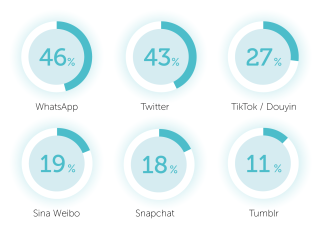

| Response | Percentage |
|---|---|
| YouTube | 71 |
| 55 | |
| 54 | |
| 46 | |
| 43 | |
| TikTok/Douyin | 27 |
| 24 | |
| 24 | |
| 20 | |
| Weixin/WeChat | 20 |
| Sina Webo | 19 |
| Snapchat | 18 |
| Tumblr | 11 |
| 10 |
Future trends in social media
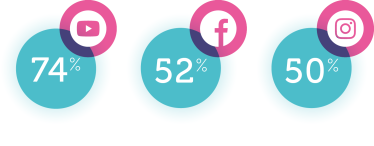
Students generally believe that the current social media sites they use to learn and/or research at university will continue to be relevant in the future. Most are open to a range of social media sites, except for students in Japan who prefer YouTube (69%), Twitter (56%) and Instagram (50%).
YouTube is again the most popular platform overall, but is particularly important to students in Brazil, Europe, and India. Students in China are the least likely to use YouTube for learning and are more supportive of their own platforms.
YouTube is the most popular platform to use in the future with 74% of students choosing this, followed by Facebook (52%) and Instagram (50%).
LinkedIn didn’t appear within the top results, as students may not be focusing on their career at this point. However, LinkedIn, along with WhatsApp, may become important for certain regions in the future. USA was the only country to have LinkedIn in their top three, with 66% of students choosing this to help them learn in the future. WhatsApp is popular among 48% of students overall, and although not widely used by organisations to support learning, it could be a worthwhile option to explore.
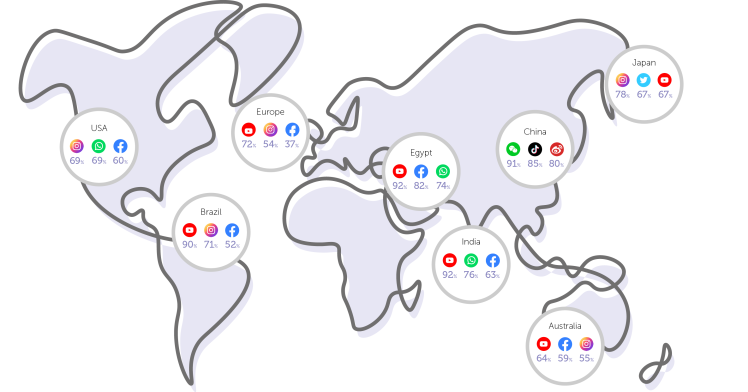
Top social media channels for sharing research
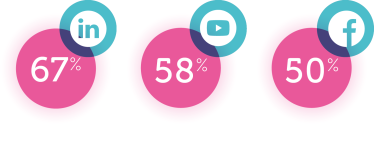
67% of academics would like research shared via LinkedIn rather than other social media sites. Those in Latin America and India were the biggest fans of LinkedIn where it was selected by 84% and 81% of academics respectively. YouTube is a top 3 platform for all regions, averaging 58% but rising to 75% in Latin America.
Top three social media sites that academics prefer for sharing research: LinkedIn (67%), YouTube (58%) and Facebook (50%).
Twitter and WhatsApp may be important for some regions, with 40% and 34% of academics respectively choosing these options. Instagram and Pinterest fair less well as potential channels for sharing research but may be relevant for some, with 29% and 11% of academics opting for these sites respectively.
Academics: which social media sites would you like to see as a way to share research?

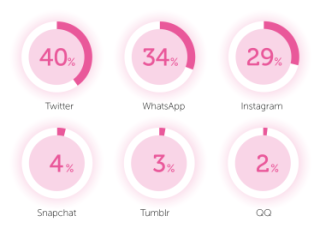
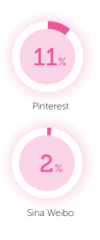
| Social media site | Percentage |
|---|---|
| 67 | |
| YouTube | 58 |
| 50 | |
| 40 | |
| 34 | |
| 29 | |
| 11 | |
| 6 | |
| Weixin/WeChat | 5 |
| TikTok/Douyin | 4 |
| Snapchat | 4 |
| Tumblr | 3 |
| 2 | |
| Sina Weibo | 2 |
Academics: Which social media sites would you like to see as a way to share research?
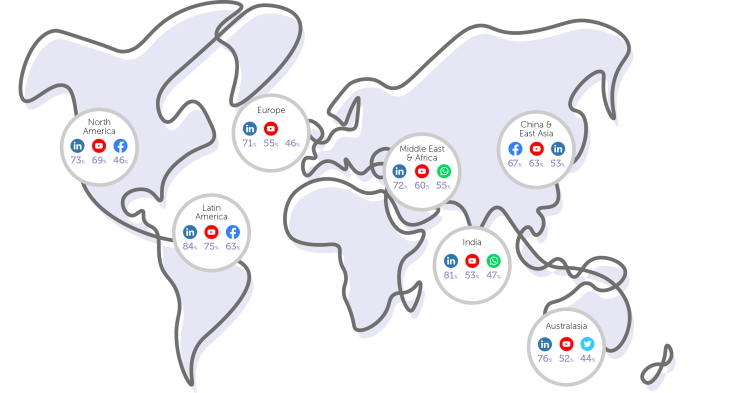
Impact of COVID-19 on research
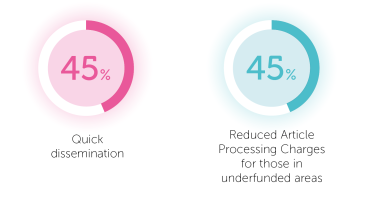
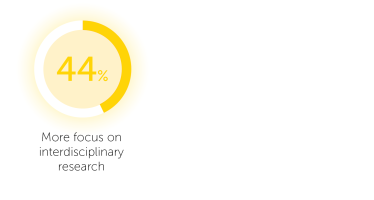
| Indicated change | Percentage |
|---|---|
| Quick dissemination | 45 |
| Reduced Article Processing Charges for those in underfunded areas | 45 |
| More focus on interdisciplinary research | 44 |
The global research community’s response to the COVID-19 pandemic has been phenomenal. Researchers have collaborated across disciplines and regions, shared research outputs rapidly through preprint servers and open platforms, and fast-tracked peer reviews. Meanwhile, publishers have supported this drive by offering free access to content and reducing time to publication.
Open and rapid sharing of research outputs have undoubtedly helped in the fight against COVID-19. The recent changes to research practice have set a precedent and paved the way to how research might be conducted and published in the future.
We asked academics how information and research need to be presented to further real-world impact. We found that most academics want change within research culture and publishing practices, and have strong ideas over how to progress the sector.
In addition, academics want more open content (43%), greater accessibility to content (43%), and metrics that help to demonstrate real-world impact (41%). 33% of academics want publishers to be more innovative in the content options they offer, 32% want more transparent peer reviews, and almost 1 in 3 (31%) want more choices of research content, beyond the journal article.
Academics: How do you think the COVID-19 pandemic has affected the way information and research needs to be presented to make it impactful?
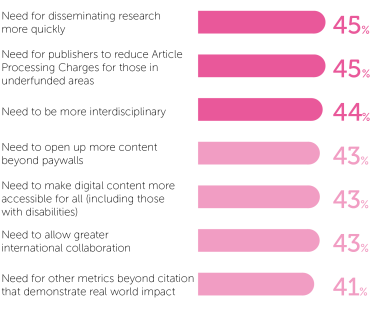
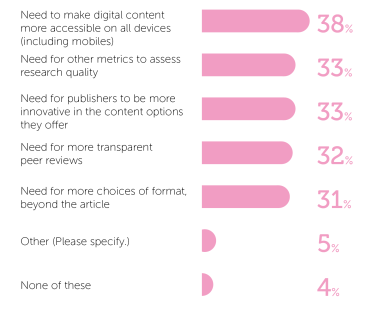
| Response | Percentage |
|---|---|
| Need for disseminating research more quickly | 45 |
| Need for publishers to reduce Article Processing Charges for those in underfunded areas | 45 |
| Need to be more interdisciplinary | 44 |
| Need to open up more content beyond paywalls | 43 |
| Need to make digital content more accessible for all (including those with disabilities) | 43 |
| Need to allow greater international collaboration | 43 |
| Need for other metrics beyond citation that demonstrate real world impact | 41 |
| Need to make digital content more accessible on all devices (including mobiles) | 38 |
| Need for other metrics to assess research quality | 33 |
| Need for publishers to be more innovative in the content options they offer | 33 |
| Need for more transparent peer reviews | 32 |
| Need for more choices of format, beyond the article | 31 |
| Other | 5 |
| None of these | 5 |
See a regional breakdown of participants in this report
Publish with us
Choose the right home for your research across our journals, books, teaching cases and open access options. Follow our guides and find the right resources to help you submit, publish and promote your work.
